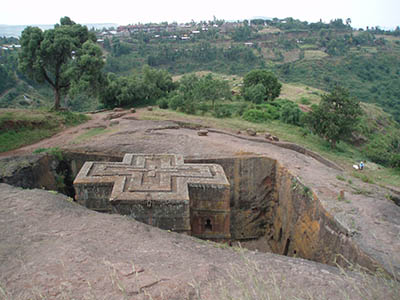
Beta Giyorgis (Church of St. George). Photo: “Bete Giyorgis 03” by Bernard Gagnon is licensed under CC-by-SA-3.0.
While many spectacular churches have been constructed in Ethiopia, perhaps the country’s most famous churches are the rock-hewn churches. Located 150 miles south of Aksum, Lalibela is the best example of Ethiopia’s hypogean (rock-hewn) architectural tradition. With 11 rock-hewn churches, Lalibela is understandably a place of pilgrimage for those in the Ethiopian Orthodox Church. The site Lalibela was originally called Roha, but it eventually took the name of King Lalibela, who ruled around 1200 C.E. as part of the Zagwe dynasty. King Lalibela is traditionally attributed as the builder of all the churches at the site.
Lalibela’s 11 churches are carved out of a hillside, which is made of soft reddish volcanic rock. The churches can be divided into two complexes—a northern and a southeastern complex—that are connected through a series of carved passageways and naturally occurring wadis. Six churches are featured in the northern complex and four in the southeastern complex. The 11th church—Beta Giyorgis (Church of St. George)—stands alone and is not part of either interconnecting complex.
In the free eBook Paul: Jewish Law and Early Christianity, learn about the cultural contexts for the theology of Paul and how Jewish traditions and law extended into early Christianity through Paul’s dual roles as a Christian missionary and a Pharisee.
The northern complex is composed of:
(1) Beta Madhane Alem (Church of the Savior of the World)
(2) Beta Maryam (Church of Mary)
(3) Beta Masqal (Church of the Cross)
(4) Beta Danagel (Church of the Virgins)
(5) Beta Mika’el (Church of Michael)
(6) Beta Golgotha (Church of Golgotha)
The southeastern complex consists of:
(7) Beta Emmanuel (Church of Emmanuel)
(8) Beta Abba Libanos (Church of Father Libanos)
(9) Beta Merkurios (Church of Mercurius)
(10) Beta Gabriel and Beta Rafa’el (the twin churches of Gabriel and Raphael)

Plan of the rock-hewn churches of Lalibela, Ethiopia. On the plan, the area marked 1 is the northern complex of churches; 2 marks the southeastern complex of churches; and 3 marks Beta Giyorgis. Photo: From David W. Phillipson, Ancient Churches of Ethiopia: Fourth–Fourteenth Centuries (New Haven and London: Yale Univ. Press, 2009), fig. 188.
Located west of the other complexes, the final—and most famous—rock-hewn church of Lalibela is (11) Beta Giyorgis (Church of St. George), which is featured in the article “Where Is the Land of Sheba—Arabia or Africa?” by Bar Kribus in the September/October 2016 issue of Biblical Archaeology Review. Shaped like a cross, Beta Giyorgis sits on a stepped platform inside a 72-by-72-foot courtyard that is 36 feet deep. Originally, it was accessible only from the west by means of a long approach—measuring nearly 100 feet—that led uphill and connected the church to the wadi below. Standing at the same level as the church, it is not immediately apparent that Beta Giyorgis is shaped like a cross, but from above, it becomes clear that not only is it shaped like a cross, but that Greek crosses have been carved into its roof as well. Beta Giyorgis has three doors and twelve windows.

Beta Giyorgis (Church of St. George), view from above. Photo: “Lalibela Église Bet Giyorgis” by Julien Demade is licensed under CC-by-SA-3.0.
Each of the windows is adorned by a cross and floral motif carved in relief above its opening. An additional nine false windows are carved into the exterior of the church at the same level as the doors, but they do not open into the church’s interior. Of all the churches at Lalibela, Beta Giyorgis is the best preserved. Dated to the late 12th or early 13th century, it is also one of the latest churches at the site. The other churches are estimated to have been built over a span of several centuries—from the 10th through the 13th centuries or later.
In the free eBook Paul: Jewish Law and Early Christianity, learn about the cultural contexts for the theology of Paul and how Jewish traditions and law extended into early Christianity through Paul’s dual roles as a Christian missionary and a Pharisee.
Related reading in Bible History Daily:
Expedition Claims Evidence of Queen of Sheba Found in Ethiopia
This Bible History Daily feature was originally published on August 25, 2016.
Get more biblical Archaeology: Become a Member
The world of the Bible is knowable. We can learn about the society where the ancient Israelites, and later Jesus and the Apostles, lived through the modern discoveries that provide us clues.
Biblical Archaeology Review is the guide on that fascinating journey. Here is your ticket to join us as we discover more and more about the biblical world and its people.
Each issue of Biblical Archaeology Review features lavishly illustrated and easy-to-understand articles such as:
• Fascinating finds from the Hebrew Bible and New Testament periods
• The latest scholarship by the world's greatest archaeologists and distinguished scholars
• Stunning color photographs, informative maps, and diagrams
• BAR's unique departments
• Reviews of the latest books on biblical archaeology
The BAS Digital Library includes:
• 45+ years of Biblical Archaeology Review
• 20+ years of Bible Review online, providing critical interpretations of biblical texts
• 8 years of Archaeology Odyssey online, exploring the ancient roots of the Western world in a scholarly and entertaining way,
• The New Encyclopedia of Archaeological Excavations in the Holy Land
• Video lectures from world-renowned experts.
• Access to 50+ curated Special Collections,
• Four highly acclaimed books, published in conjunction with the Smithsonian Institution: Aspects of Monotheism, Feminist Approaches to the Bible, The Rise of Ancient Israel and The Search for Jesus.
The All-Access membership pass is the way to get to know the Bible through biblical archaeology.
The post The Rock-Hewn Churches of Lalibela appeared first on Biblical Archaeology Society.

0 Commentaires